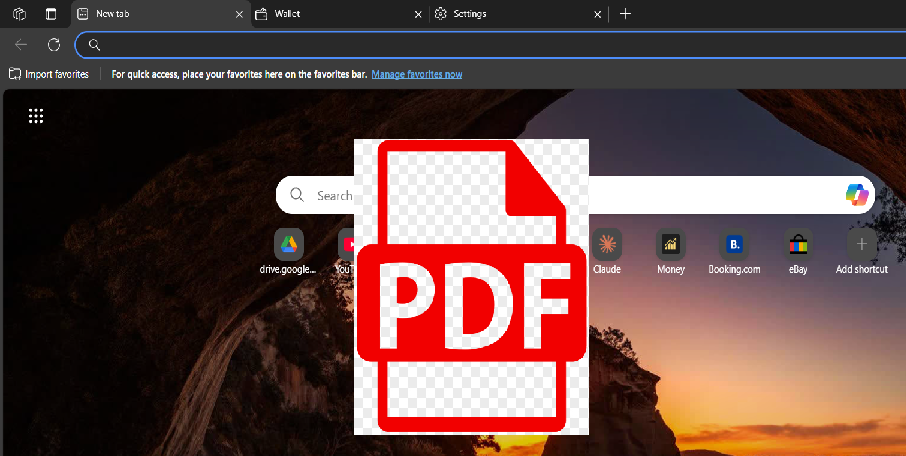In this article, we will guide you on how to use Microsoft Edge PDF reader.
Your Microsoft Edge browser already includes a powerful, built-in PDF reader packed with useful features.
You can open, read, annotate, and even have PDFs read aloud without installing anything extra.
Let’s explore how you can make the most of the Microsoft Edge PDF reader.
How To Use Microsoft Edge PDF Reader
Opening PDFs in Edge: It’s (Usually) Automatic
Most of the time, opening a PDF in Edge requires no effort.
- Click a Web Link: When you click a link to a PDF file online, Edge typically opens it directly in a new browser tab.
- Open Local Files: Double-click a PDF file saved on your computer. If Edge is your default PDF handler, it will open right up.
- Drag and Drop: Simply drag a PDF file from your computer folder directly onto an open Edge browser window.
If another program opens your PDFs by default, you can right-click the PDF file, choose “Open with,” and select “Microsoft Edge.”
Navigating Your Documents with Ease
Once your PDF is open, moving around is simple.
- Scroll: Use your mouse wheel, trackpad, or the scroll bar on the right side to move up and down pages.
- Page Navigation: Look for the toolbar that appears (usually at the top when you move your mouse). Enter a specific page number in the box and press Enter to jump directly there. You’ll also see arrows to move to the previous or next page.
- Zoom: Use the “+” and “-” buttons on the toolbar to zoom in or out for comfortable reading. You can also often use Ctrl + Mouse Wheel.
- Fit to Page/Width: Find the view options on the toolbar (often looks like a page icon) to adjust the display – fit one full page to the screen or fit the page width to the browser window.
- Table of Contents: If the PDF includes a table of contents, click the “Contents” icon (usually looks like a list) on the left side to quickly navigate sections.
Making Your Mark: Annotations and Notes
Edge transforms from a simple reader into an interactive tool with its annotation features. Look for these options on the toolbar:
- Highlight: Select the highlighter tool (often a marker pen icon), choose your color, and drag your cursor over text to emphasize important passages.
- Draw: Use the draw tool (pencil icon) to freehand draw, circle items, or make quick sketches directly on the PDF. You can usually adjust color and line thickness.
- Add Text Notes: Click the “Add text” button (often a “T” in a box). Click anywhere on the PDF where you want to add a typed comment or note.
Beyond Reading: Powerful Edge PDF Tools
Edge offers more than just basic viewing:
- Read Aloud: Let Edge read the PDF content to you! Click the “Read aloud” button (often an “A” with soundwaves) on the toolbar. You can adjust the voice and speed. This is fantastic for accessibility or multitasking. Learn more about accessibility features in Edge on the official Microsoft Accessibility page.
- Search Text: Need to find a specific word or phrase? Press Ctrl+F (or Cmd+F on Mac) or click the magnifying glass icon on the toolbar. Type your search term, and Edge will highlight all instances within the document.
- Fill Forms: Edge often recognizes fillable form fields in PDFs. Simply click into a field and start typing. You can easily fill out applications, surveys, and other forms directly in your browser.
Saving and Sharing Your Work
After annotating or filling out a form, you need to save your changes.
- Save: Click the “Save” icon (usually a floppy disk symbol) on the toolbar. This typically overwrites the original file if it’s a local file you have permission to modify. Be cautious with this option.
- Save As: It’s often safer to use the “Save as” icon (sometimes a disk with a pencil, or found under a “…” menu). This lets you save a new copy of the PDF with your annotations included, preserving the original document. Choose a new name or location for your edited file.
- Print: Click the printer icon on the toolbar to print the PDF, including any annotations you’ve added.
Microsoft Edge provides a surprisingly robust and convenient way to handle PDF documents without needing extra software.
It streamlines your workflow by keeping everything within the browser you already use.
IT Security / Cyber Security Experts.
Technology Enthusiasm.
Love to read, test and write about IT, Cyber Security and Technology.
The Geek coming from the things I love and how I look.

